


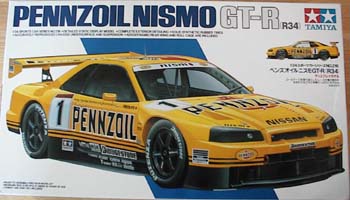 Tamiya
1/24th Pennzoil Nismo Nissan Skyline GT-R
Tamiya
1/24th Pennzoil Nismo Nissan Skyline GT-R
by John Jameson
Background
The Nissan Skyline is a world renowned sports car except, of course, in North America where the Skyline is not imported and never seen. In North America the Skyline remains a mystery. When you realize the class of cars the Skyline is comparable to, one understands what those of us in North America are missing out on. The Pennzoil Nismo Nissan Skyline GT-R that this kit represents is Team Nismo's entry in the 1999 Japanese Grand Touring Championship (JGTC) endurance series. The Pennzoil entry won the JGTC championship in 1998 with the R33 version of the Skyline.
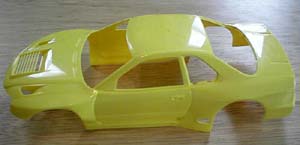 |
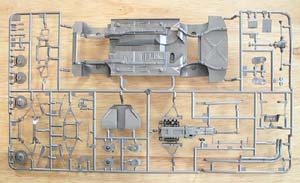 |
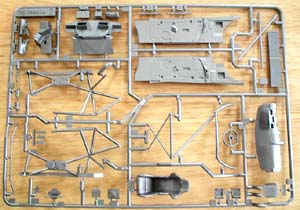 |
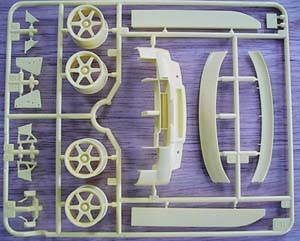 |
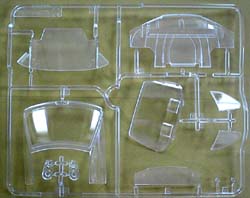 |
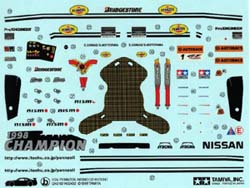 |
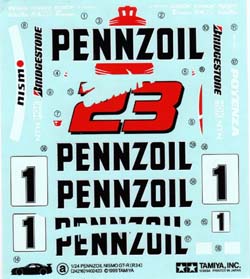 |
This kit represents the 1999 R34 model Skyline. The Japanese Grand Touring Championship series (JGTC) is a seven race series run from March to November in Japan. The Pennzoil Nismo entry competes in the GT500 class of the JGTC against other well know sports cars such as the Toyota Supra, Honda/Acura NSX, Porsche 911 GT-2, Ferrari F355, and the Dodge Viper. The JGTC series are 300Km endurance races in which each car must make a minimum of one pit stop for fuel and a driver change. In addition, the top three finishers are required to add a handicap weight load to their cars for the following race.
The Kit
The Pennzoil Skyline GT-R kit is typical of recent competition sportscar kits made by Tamiya. The kit retails for 1800 Yen (About US$18) and consists of four sprues A-D, a body, and rubber tires.
Sprue A contains 35 pieces and molded in a silver/grey color and consists of the chassis, suspension, brake discs, exhaust, and engine and transmission pieces.
Sprue B contains 32 pieces and again molded in silver/gray and consists of the components of the cockpit interior, roll cage, seat, dash, rear deck and other misc. cockpit items.
Sprue C contains 18 pieces and is molded in Yellow and contains the front bumper assembly, wheels, mirrors and front and rear wings.
Sprue D contains 11 pieces and is molded in transparent plastic and consists of the windshield, windows, headlights and two undertray pieces.
The kit also contains a set of Potenza tire decals, a sheet of sponsor decals, a second small sheet of interior cockpit decals, and a set of pre-cut paint masks, to mask the windshield and windows to effectively paint the black trim on the windshield and windows.
The kit instructions are also typical of recent Tamiya kits. Consisting of 10 Pages, Seventeen steps, an introduction giving some background and decal marking views. As for Tamiya paints specified, the instructions call for TS-Pearl Yellow as the body color. This is a 'one off' color and may not be readily available outside of Japan. It mentions TS-16 Yellow for an alternative body color. A suitable Pearl Yellow readily available from Testors or Boyd may be a better choice.
Two other spray lacquers are also specified, TS-14 Black and AS-12 Bare Metal Silver. The AS-12 may also be difficult to obtain outside of Japan, but a 'Bare Metal Silver' should not be difficult to find substitute for.
Tamiya enamels and acrylics specified include, X-1 Black, X-7 Red, X-11 Chrome Silver, X-12 Gold Leaf, X-13 Metallic Blue, X-18 Semi-Gloss Black, X-26 Clear Orange, X-27 Clear Red, XF-1 Flat Black, XF-4 Yellow Green, XF-16 Flat Aluminum, XF-28 Dark Copper, XF-56 Metallic Grey, XF-59 Desert Yellow, and XF-63 German Grey.
Extras
Tamiya will also issue an identical kit with a different paint scheme, the Blue Calsonic livery that has been seen twice before with prior releases of Skyline kits.
There are several Japanese aftermarket companies that are making Photo-Etch detail plates for this kit. Among them are the Studio 27 version that is retailing for 1200 Yen (US$12), Modelers retailing for 1200 Yen (US$12), and Acu-steon for 1400 Yen (US$14). The Studio 27 version contains wing end plates, eight radiator grills, slotted brake disks plates to attach to the outside of the kit disks, side mirror inserts, brake/clutch/gas pedal piece, rear wing mounts, wiper assembly, nine bonnet pins, tow hooks, and a fuel filler piece.
There is also an alternative decal sheet available from Studio 27. It is the Flouro-red and white colors of the Zexel/Autobacs livery. The Fluoro-red may be painted and may be difficult to match as most Fluoro colors are. Especially since the decal placement guide is a colored drawing and the colors do not match the color of this car as I have seen it on the web. The decals are top notch and appear to be silk screened with very little carrier film. They contain two sets white bases for the number placement and other white sponsor decals to ensure no bleed through of the fluoro color.
Conclusion
This looks to be another fine kit from Tamiya. The decals are excellent, the molding clean and sharp. The inclusion of window masks is a bonus that recent Tamiya sportscar and rally kits have been issued with. It makes painting the black window trim much easier. The kit is essentially curbside, there is no real engine detail other than the underside transmission and drive train. The addition of clear molded under body panels also allows the builder to show off some underside details that would otherwise be covered. There are a set of decals for the seatbelts, which will need to be replaced with small cloth belts and hardware for a better look. This car may not be all that well known here in North America but it is a sharp looking kit that will look excellent next to some of the better known sportscars kits such as the Porsche GT-2 and Acura NSX.

Previous: Contents







